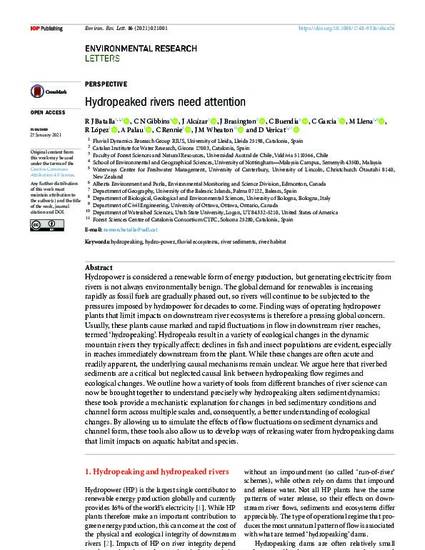
Article
Hydropeaked Rivers Need Attention
Environmental Research Letters
(2021)
Abstract
Hydropower is considered a renewable form of energy production, but generating electricity from rivers is not always environmentally benign. The global demand for renewables is increasing rapidly as fossil fuels are gradually phased out, so rivers will continue to be subjected to the pressures imposed by hydropower for decades to come. Finding ways of operating hydropower plants that limit impacts on downstream river ecosystems is therefore a pressing global concern. Usually, these plants cause marked and rapid fluctuations in flow in downstream river reaches, termed 'hydropeaking'. Hydropeaks result in a variety of ecological changes in the dynamic mountain rivers they typically affect; declines in fish and insect populations are evident, especially in reaches immediately downstream from the plant. While these changes are often acute and readily apparent, the underlying causal mechanisms remain unclear. We argue here that riverbed sediments are a critical but neglected causal link between hydropeaking flow regimes and ecological changes. We outline how a variety of tools from different branches of river science can now be brought together to understand precisely why hydropeaking alters sediment dynamics; these tools provide a mechanistic explanation for changes in bed sedimentary conditions and channel form across multiple scales and, consequently, a better understanding of ecological changes. By allowing us to simulate the effects of flow fluctuations on sediment dynamics and channel form, these tools also allow us to develop ways of releasing water from hydropeaking dams that limit impacts on aquatic habitat and species.
Disciplines
Publication Date
2021
DOI
https://doi.org/10.1088/1748-9326/abce26
Citation Information
Joseph M. Wheaton. "Hydropeaked Rivers Need Attention" Environmental Research Letters Vol. 16 Iss. 2 (2021) p. 021001 Available at: http://works.bepress.com/joseph_wheaton/230/
